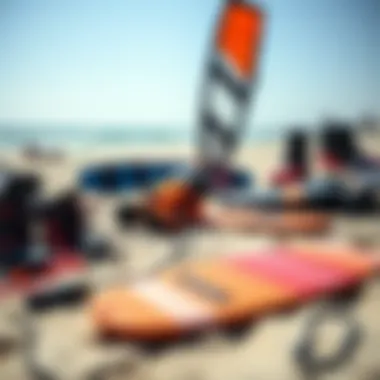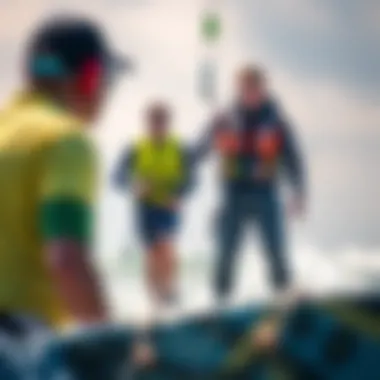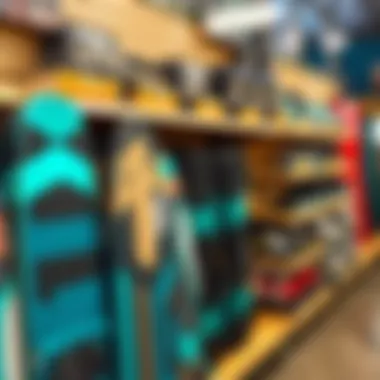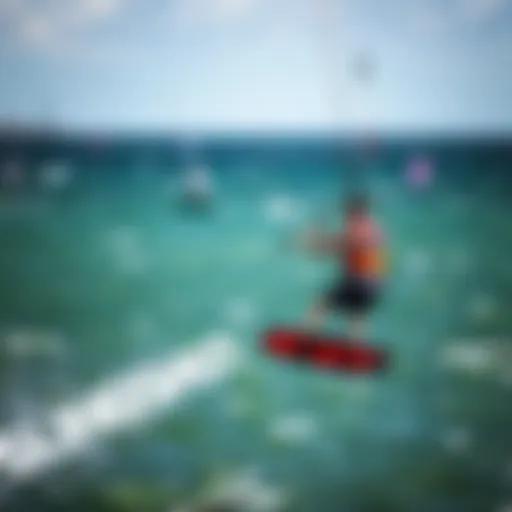Essential Guide to Beginner Kiteboard Packages


Intro
Kiteboarding attracts many outdoor adventurers every year. It's a sport that combines skills in joy, thrust, and occasionally, a splash of saltwater. For those stepping into this world, the array of kiteboard packages available can be overwhelming. From varying types of gear to methods of selecting the right setup, one might feel like a fish out of water. The aim of this guide is to demystify the process and to empower newbies with the knowledge they need to make informed decisions.
Understanding the essence of kiteboarding is crucial. It involves not just flying a kite, but also mastering the board under your feet while harnessing the power of the wind. From your first ride to advanced techniques, having the right equipment makes a world of difference. This guide serves as a compass, helping you navigate through essential gear, selection tips, safety measures, budgeting, and support within the kiteboarding community.
Gear and Equipment
Essential Kiteboarding Gear: A Comprehensive Guide
Venturing into kiteboarding, it's important to be well-versed in the essential gear. The right equipment can make or break your experience on the water. Here are the key components you should consider:
- Kite: The heart of kiteboarding. Kites come in different shapes and sizes. A beginners' kite typically has a larger surface area, which helps generate lift more easily and offers greater stability.
- Board: Kiteboards vary in size and type. A larger and wider board is recommended for beginners, providing better flotation and ease in controlling.
- Harness: A necessary piece, the harness connects you to the kite. The two main types are seat and waist harnesses. Seat harnesses are great for those just starting since they maintain stability.
- Control Bar and Lines: These are your connection to the kite. The control bar helps control the kite’s speed and direction. Make sure the lines are strong and free from tangles.
- Safety Gear: Always use a helmet and impact vest for protection. These keep you safe from unexpected falls or the kite getting caught in the wrong wind.
"Investing in quality gear from the start can enhance your learning curve and overall enjoyment."
Maintenance Tips for Kiteboarding Equipment
Once you've got your gear sorted, maintaining it is just as crucial. Proper care can extend the life of your kiteboarding equipment significantly. Here are some tips:
- Dry and Store Properly: After a session, rinse your gear with freshwater to remove salt or sand. Dry it fully before storing in a cool, dry place.
- Check for Damage: Regularly inspect your kite, lines, and board for any signs of wear and tear. A small tear can lead to bigger issues.
- Handle with Care: Be careful during launches and landings. Keeping the lines untangled helps prevent damage.
- Follow Manufacturer's Recommendations: Read the manuals for specific guidance on maintenance. Different brands may have unique care instructions.
Understanding these aspects of gear and equipment is vital for any beginner kiteboarder. It allows you to select the right tools for riding the waves and enjoying the experience without hurdles.
Understanding Kiteboarding
Kiteboarding is an exhilarating sport that blends elements of surfing, snowboarding, and windsurfing. It's crucial for newcomers to grasp the fundamentals of this captivating activity, as it opens the door to understanding how different aspects of the sport interconnect. By familiarizing oneself with the principles of kiteboarding, beginners can develop not only a foundation of knowledge, but also a passion that can transform their outdoor adventures.
The Basics of Kiteboarding
At its core, kiteboarding involves riding a board while being propelled by a harness-attached kite. The kite, steered by the rider through a control bar, catches the wind, translating it into forward motion across the water. This sport can be enjoyed on oceans, lakes, and even rivers, making it accessible to a wide array of enthusiasts.
A key aspect is not just getting started, but understanding the dynamics involved. Factors such as wind strength, kite size, and the rider's weight all play significant roles in achieving optimal performance. Understanding these elements helps assure that safety and performance are balanced as you embark on your kiteboarding journey.
Equipment Demystified
Diversifying into the world of kiteboarding gear can feel overwhelming at first glance. However, breaking it down into its core components can make it much more digestible.
Components of Kiteboarding Gear
Kiteboarding gear comprises several essential elements including the kite, board, harness, and safety gear. Each of these components serves a specific purpose and contributes towards the intended performance of the rider.
- Kite: This is the driving engine of the sport. Kites come in various shapes and sizes, designed for different conditions and rider skill levels. A beginner typically benefits from a stable and forgiving kite.
- Board: The surface upon which the rider stands is critical for performance. Boards can vary significantly in style and material, affecting how they interact with water.
- Harness: This connects the rider to the kite and allows for better control. Choosing the right type that fits well is indispensable for comfort and efficiency.
- Safety gear: While advancing to intermediate skills, protective equipment such as helmets and impact vests become important to mitigate risk and ensure safety during falls or crashes.
When novices select their kit, looking for well-constructed gear that emphasizes safety and ease of use is a smart choice. Equipment that promotes steadiness and straightforward handling is beneficial for beginners, ensuring fewer mishaps while learning.
Role of Each Component in Performance
The interplay between the components of kiteboarding gear is what dictates performance. Each item fulfills a unique role that contributes to the overall experience.
- Kite Performance: The size and design can greatly affect how quickly or maneuverably the rider can navigate the water. A larger kite catches more wind but requires more skill to manage. Meanwhile, a smaller kite might be easier for beginners to control while still offering ample power.
- Board Functionality: A well-chosen board not only impacts speed but also how easily a rider can cut through waves or land tricks. Materials matter here, as some boards will offer a softer ride, absorbing shocks better, especially for those just learning.
- Harness Efficiency: The harness allows the rider to transfer the kite's pull directly to their body. A comfortable harness reduces fatigue and enhances focus on learning the necessary skills.
- Safety Gear Assurance: Wearing safety equipment isn't just about minimizing injuries; it boosts confidence, allowing beginners to push their limits without excessive worry about consequences.
Each of these elements comes together to create a riding experience that can be thrilling and rewarding. For beginners, understanding how these components work can not only enhance their capabilities but also foster a sense of confidence that is vital when learning to kiteboard.
"Safety ensures the joy of kiteboarding. Gear that fits well and works seamlessly allows you to focus on honing your skills rather than worrying about mishaps."
Whether navigating the basics or delving deeper into the mechanics of kiteboarding gear, being equipped with knowledge is pivotal for new riders. It’s about enjoying the thrill while being safeguarded by understanding how every part works in tandem.
Importance of a Beginner Kiteboard Package
When venturing into kiteboarding, grasping the significance of a beginner kiteboard package is essential for a smooth ride into this exhilarating sport. These packages are tailored for novices, ensuring that new riders have a well-rounded experience as they learn to harness the wind and water.
Designed for New Riders
Beginner kiteboard packages are specifically crafted to cater to the needs of those just starting out. Each component, from the kite to the board and harness, is made with user-friendliness in mind. The kites in these packages often feature simpler control systems, which means new riders can focus on learning the ropes without getting overwhelmed by intricate designs. Moreover, the boards tend to have more stability for ease of use when learning to navigate through the water.
The benefit here is akin to learning to drive a car with an automatic transmission instead of a manual. It abstracts away various complexities, allowing beginners to get comfortable with the sport.
Cost-Effectiveness
Investing in a beginner kiteboard package often proves to be a financially sound decision. Let's face it: diving headfirst into a new sport can be pricey, and the thought of purchasing individual components can send one's budget soaring sky-high. However, packages tend to combine essential gear at a more economical price than purchasing each item separately.


Often, brands group complementary items in a package, which generally includes a kite, a board, a harness, and tools for assembly. This way, new kiteboarders can save money while ensuring they have all the necessary gear for their first steps in kiteboarding. It’s like buying a bundled deal at a restaurant, often cheaper than ordering each item on the menu.
Furthermore, since these packages are designed for beginners, they provide a peace of mind for novice kiteboarders, allowing them to focus on building their skills rather than worrying about whether they picked the right board or kite.
In summary, understanding the importance of a beginner kiteboard package is crucial for anyone looking to dip their toes into this thrilling sport. Not only do these packages simplify the initial learning process, but they also offer a cost-effective solution, making it possible for aspiring kiteboarders to fully engage without straining their wallets.
Components of a Beginner Kiteboard Package
When diving into the world of kiteboarding, understanding the components of a beginner kiteboard package can make all the difference. A well-rounded package caters to the needs of novices, allowing them to learn the ropes efficiently and safely. Selecting the right gear ultimately enhances performance and learning experience. Below we’ll delve into the core components—each having a distinct role that contributes to a smooth ride for new kiteboarders.
Kite
Types of Kites
Kites are the heart and soul of kiteboarding, and understanding the types of kites is crucial. Each kite design serves different wind conditions and rider preferences. Typically, you'll encounter two primary types: flat kites and bow kites.
- Flat Kites: These are ideal for experienced riders who want speed and performance. However, they might not be the best choice for beginners due to their sensitivity to wind.
- Bow Kites: These are great for newcomers because they offer better stability and a larger wind range. They are docile, making it easier for new riders to control them.
The feature that sets bow kites apart is their ability to depower effectively, which reduces lift and makes crashing less severe. This quality is invaluable for learners still mastering their skills.
Choosing the Right Size
The size of the kite is another pivotal aspect. A kite that’s too large can easily overpower a beginner, while one that’s too small might not catch enough wind, leading to frustration. A common starting point is roughly 7 to 10 square meters for beginners, depending on their weight and the wind conditions.
- Larger Kites: They excel in light winds, enabling riders to get up on the board easily.
- Smaller Kites: Though they handle stronger winds better, they demand more skill to maneuver, making them less favorable for newbies.
Understanding how the size affects lift and control will aid you in selecting a kite that's not just functional but also enhances your learning curve.
Board
Different Board Styles
Moving on to the board, there’s a range of board styles, each designed for a specific riding style and conditions. For starters:
- Twin-Tip Boards: These are the most common choice for beginners. They allow riders to ride in both directions without needing to turn around.
- Direction Boards: These boards are like surfboards and are typically used for wave riding. They can be challenging for beginners due to their directional nature.
The twin-tip is favored because its symmetrical shape lends to stability, making it easier for new riders to balance.
Factors Influencing Board Selection
When it comes to factors influencing board selection, several elements come into play. Weight, skill level, and intended water conditions are critical considerations. A board's volume impacts how it floats and maneuvers. Beginners often benefit from boards with higher volume, making it easier to stay above water.
- Skill Level: Newcomers should go for softer boards, as they are generally more forgiving and easier to control.
- Water Conditions: Flat water is forgiving for new riders, whereas choppy conditions require more specialized boards.
Choosing the right board can significantly affect how learning progresses and how quickly one can adapt to different environments.
Safety Gear
Importance of Protective Equipment
As with any sport, safety should never be overlooked. The importance of protective equipment cannot be overstated. Helmets, impact vests, and wrist guards are just a few essentials that can prevent injuries during falls or crashes.
Protective gear not only safeguards against common injuries but also builds a rider’s confidence. Many beginners face apprehensions about falling, and wearing gear that offers a bit of extra padding can ease those worries.
Recommended Gear for Beginners
When it comes to recommended gear for beginners, here are some essentials:
- Helmets: Protect your noggin from unexpected bumps or falls.
- Impact Vests: Provide buoyancy and reduce the risk of injury during falls.
- Wetsuits: Essential for warmth in cold waters and added protection against abrasions.
These pieces of gear not only enhance safety but also contribute to overall enjoyment by allowing beginners to ride with peace of mind.
Harness
Types of Harnesses
The types of harnesses available might be confusing at first glance. You generally have two options: waist harnesses and seat harnesses.
- Waist Harnesses: These are popular among most kiteboarders. They allow for great freedom of movement and are suitable for various tricks.
- Seat Harnesses: These provide more support and are ideal for beginners who prefer more stability and comfort.
Waist harnesses generally offer more versatility as you progress, while seat harnesses can ease the learning curve for those just starting.
Selecting a Suitable Harness


When selecting a suitable harness, it’s essential to consider factors such as comfort, support, and adjustability. A harness that fits well will not only make riding easier but can also prevent discomfort while on the water.
- Fit and Comfort: Ensure the harness is snug but not too tight, allowing for a full range of movement.
- Support: Look for padded sections that can help with longer sessions on the water.
Selecting the Right Package
Choosing the right kiteboard package is an important aspect of entering the sport. With many options on the market, making an informed decision can save you both time and money in the long run. For beginners, the key is to find a package that aligns with your current skill level and future aspirations. Balancing features, quality, and budget is fundamental to ensuring that your kiteboarding experience is both enjoyable and safe.
Researching Brands
Reputable Brands to Consider
When diving into the world of kiteboarding, it's crucial to familiarize yourself with the reputable brands that dominate the industry. Companies like Naish, Cabrinha, and Duotone have built their reputations through a history of quality and innovation. These brands not only offer solid products but often provide extensive customer support, which is invaluable for beginners.
Their significant experience in the market means they’re consistently working to improve their gear. For instance, Naish is known for its durability and reliability, ensuring that new riders can focus on learning without constantly worrying about equipment failure during crucial moments. This tends to result in a more relaxed learning experience, allowing newcomers to adapt to the dynamics of kiteboarding with less distraction.
However, while these brands shine in many areas, it's essential to check for specific models within their range. Some may suit your needs better than others, primarily based on your riding style and the conditions you'll be facing.
Customization Options
Customization in kiteboarding packages has taken off in recent years, allowing beginners to tailor their gear to better fit their needs. This can include specific sizes for kites and boards or personal preferences for harness styles. The chance to customize your setup can vastly enhance your comfort and performance, making your early experiences in the sport much more enjoyable.
For example, Cabrinha offers kites that allow for adjustable settings to better control power and responsiveness during rides, making them a preferred choice. This flexibility can aid beginners significantly, as each rider may respond differently to wind conditions and board dimensions. The downside, however, is that too many options might feel overwhelming at first; hence, doing thorough research here is paramount.
Important Features
Build Quality
The build quality of your kiteboarding package is the backbone of your gear's performance. High-quality materials can withstand the wear and tear of ocean water and UV rays, ensuring longevity. Brands like Slingshot and F-One are frequently praised for their sturdy construction, which often incorporates advanced technologies in materials and design.
One unique feature among higher-end models is the use of reinforced stitching and layered materials, which significantly increase the durability of kites under various conditions. This advantage is particularly important for beginners who might not yet be adept at managing different environmental factors while riding. However, lower-end models tend to skimp on these qualities, which might lead to purchasing replacements sooner than anticipated—never a pleasant surprise.
User Reviews and Ratings
In today's connected world, user reviews and ratings provide a wealth of information that can shape your purchasing decisions. Before settling on a particular kiteboard package, scanning through various feedback sources such as Reddit forums or niche kiteboarding websites can reveal insights that might not be immediately obvious from specs alone.
A highly-rated product like the Duotone Neo can stand out not just for its features but for an overall positive consensus among users regarding performance and reliability. Many beginners find solace in seeing what others like or dislike about a package, helping them manage expectations and make clearer choices. However, it's essential to keep in mind that individual preferences can vary—it’s always best to weigh multiple reviews before making a decision.
"When selecting gear, always prioritize quality and fit over brand name. Personal experiences can lead to greater insights than marketing campaigns."
Choosing the right kiteboarding package goes beyond just numbers and sizes; it’s about understanding your personal needs and the environment. Investing time in researching and considering various aspects can lead to a much more fulfilling kiteboarding journey.
Budgeting for a Beginner Kiteboard Package
Budgeting for a beginner kiteboard package is crucial to ensure that new riders make smart investment choices without breaking the bank. Kiteboarding can appear as a costly endeavor, which might deter some novices. However, understanding how to allocate funds effectively—while still getting quality gear—is essential. Not only does this awareness empower beginners to make informed decisions, it also allows them to enjoy the sport without the financial burden often associated with it.
Setting Realistic Expectations
Starting kiteboarding may seem daunting, especially when confronted with various pricing tiers. New riders should approach the expense with a clear, realistic mindset. Expecting to pay a significant amount can lead to discouragement, while anticipating too little can result in disappointment over gear quality. It’s all about finding that sweet spot. Consider your budget carefully, and take into account that while cost can limit options, it can also shape your initial kiteboarding experience.
Cost Ranges
When diving into the specifics, it’s important to understand how the cost landscape looks for beginners.
Typical Pricing for Packages
Typical pricing for packages can vary widely, with packages often ranging from $600 to over $1,500. Beginners can find decent setups at around the $800 mark, which typically include a kite, board, safety gear, and a harness. This price range provides a balance, allowing you access to reliable equipment while ensuring you don’t feel like you’ve thrown cash out the window.
One noteworthy characteristic of typical pricing is its blended approach—better quality gear adjusts slightly up in price, but also enhances the overall learning experience. A sturdy kite can withstand strong winds, making it a favorable investment for practice and initial rides. Below is a breakdown of what you might expect within this price range:
- Under $800: Basic setups often suitable for entry-level use; however, they might lack in durability.
- $800 to $1,200: This range often includes well-reviewed brands that offer decent quality and performance.
- Above $1,200: Premium packages; ideal for those who are committed and see themselves continuing in the sport.
In comparison, brands like Slingshot or Naish have built their reputation around quality gear that encapsulates reliability from the start.
Potential Additional Costs
Potential additional costs can sneak up on beginners if they aren't vigilant. Besides the initial investment in gear, riders should factor in ongoing expenses such as maintenance, repairs, and local travel. All in all, a kiteboarder’s commitment doesn’t stop at purchase; it evolves into an ongoing financial consideration.
For instance, regular inspections can become necessary to maintain safety and performance, which further adds to long-term costs. Furthermore, lessons or instructor fees are often justified expenses for beginners who want to expedite their learning curve. Here’s a quick list of potential costs to keep in mind:
- Gear maintenance: Repairs and replacements can add up within the first year.
- Safety lessons: Many local kiteboarding schools offer courses tailored for beginners.
- Travel expenses: Reaching prime kiteboarding locations can involve additional costs for transportation.
This ensures that novices enter the sport fully aware of the financial commitment involved, enabling them to enjoy their kiteboarding journey without constantly worrying about expenditures. Being open about the total costs leads to better planning and a more enjoyable experience.


Safety Considerations
Safety in kiteboarding is not just a recommendation; it's a necessity. For beginners, understanding safety considerations can make the difference between an exhilarating experience and a dangerous one. Numerous factors contribute to a safe kiteboarding session, from gear to environmental conditions. Here, we unravel the essential elements that underscore the significance of safety in this thrilling sport.
Essential Safety Practices
When you're out on the water, having a solid grip on fundamental safety practices could literally save your life. Here are a few essentials to keep in mind:
- Wear the Right Gear: A well-fitted life jacket isn't just a good idea—it's your best friend on the water. Make sure it’s designed for kiteboarding.
- Use a Leash: Employ a kite leash to keep your kite within reach. This prevents it from flying away and creates a vital tether during mishaps.
- Understand Your Equipment: Before you hit the waves, familiarize yourself with every bit of gear. Know how to release your kite quickly in case of an emergency. This knowledge can be a game changer.
- Pre-Flight Checks: Go through a thorough checklist before launching your kite. Checking lines, inflatables, and connections can prevent a lot of chaos down the line.
- Kite Control: Learn to control the kite carefully. The more skilled you are, the safer you will be.
Ultimately, practicing these safety measures regularly forms a habit that enhances not just your safety, but the safety of those around you.
Understanding Weather Conditions
Mother Nature can be unpredictable, especially when you're out on the water. Understanding the weather allows you to make informed decisions that can prevent risks. Keep an eye on:
- Wind Speeds: Know what wind speeds are safe for your skill level. Beginners should aim for lighter winds, generally between 10 to 15 knots.
- Weather Forecasts: Always check weather forecasts. Thunderstorms and wind gusts can appear quickly, changing conditions for the worse.
- Water Conditions: Is the water choppy or smooth? Are there strong currents? These factors affect your ride, so assess them before heading out.
- Navigational Hazards: Be mindful of rocks, shallow waters, and other obstacles that might not be visible at first glance, especially with changing tides.
To sum it up, being mindful of the weather and its conditions is just as crucial as understanding your gear. Staying informed can protect you from avoidable accidents, allowing you to enjoy this exhilarating sport to its fullest.
"Safety isn’t just about gear; it’s about being wise."
By adopting rigorous safety practices and embracing a keen awareness of weather conditions, novice kiteboarders can set the stage for a safe and enjoyable adventure on the water. It's essential to remember that kiteboarding isn't just about experiencing the thrill—it's about doing so in a manner that respects both the sport and your personal safety. For further safety recommendations, consider visiting resources such as Wilderness.net or National park service.
Gaining Skills as a Beginner
Learning to kiteboard is not merely about having the right equipment. It's also about acquiring the skills needed to ride safely and confidently. Gaining skills as a beginner is crucial because it lays the foundation for long-term enjoyment and progress in the sport. Without proper skills, the thrill of soaring over the water can quickly turn into frustration or, worse, accidents.
Learning from Professionals
One of the best ways to kickstart your kiteboarding journey is to get lessons from experienced instructors. Pros have been through the ropes and know the ins and outs of the sport.
- Tailored Instruction: Each lesson can be adapted to your specific needs, addressing your strengths and weaknesses. This personalized approach can help you progress faster than trying to learn on your own.
- Proper Techniques: Instructors teach more than just how to manage the kite. They also introduce essential techniques for falling safely, re-launching the kite, and executing basic maneuvers.
- Confidence Building: With supervision, beginners often feel more comfortable pushing their limits. Having someone knowledgeable on hand to guide you through the initial uncertainties is invaluable.
"Learning with a pro is like having a cheat code for the game of kiteboarding. They can spot the errors you might not see and provide instant feedback."
Joining a Community
Being a part of a wider kiteboarding community can be a game-changer for beginners. The support and encouragement you gain from likeminded people can enhance your learning experience significantly.
Local Kiteboarding Schools
Local kiteboarding schools are often a hub of activity. They provide an excellent environment for beginners to learn and connect with more experienced riders. These schools usually have qualified instructors and a variety of equipment, which can be quite a relief for newcomers who might feel overwhelmed by choices.
- Structured Learning: Many of these schools offer structured lesson plans that guide beginners from the basics all the way to more advanced techniques. Such a framework ensures that you don’t miss out on essential skills.
- Community Connection: Schools often host events and parties, connecting you to a network of local kiteboarders. Building friendships in this kind of environment can be encouraging and motivational.
- Unique Equipment Access: Schools typically have updated gear that often varies from session to session. You get to try out different configurations, helping you determine what suits your style best before making a purchase.
Online Forums and Groups
Online forums and groups provide another avenue for beginners to learn and gain support. Websites like Reddit offer spaces for discussion and advice on all things kiteboarding. These platforms can be a treasure trove of information.
- Peer-to-Peer Learning: Here, you can easily ask questions and receive advice from more experienced kiteboarders without geographical constraints. You may find tips tailored to your local conditions, experiences shared by others who learned the same skills, and much more.
- Experience Sharing: Members often share personal stories about their fails and successes. This kind of sharing brings a sense of realness that can motivate newcomers to keep trying, even after a setback.
- Resource Pooling: Members of kiteboarding forums usually share valuable resources, including local conditions, gear recommendations, or even plans for meet-ups.
No matter how you choose to gain your skills, engaging with professionals, local schools, and online communities offers a well-rounded approach to learning. All these elements collectively enhance a beginner’s journey, paving the way toward becoming a competent and confident kiteboarder.
Maintaining Your Gear
Keeping your kiteboarding gear in tip-top shape is crucial for both performance and safety. The better you maintain your equipment, the longer it lasts, and the safer your kiteboarding experiences become. A well-cared-for kite and board can withstand the elements, deliver better performance, and ultimately enhance your enjoyment on the water.
Care Tips for Kites and Boards
Caring for your kites and boards isn't just about aesthetics; it's about ensuring everything works smoothly and efficiently. Here are some practical tips:
- Rinse After Use: Every time you come off the water, it's vital to rinse your kite and board with fresh water. Saltwater and sand can cause wear and tear, leading to premature damage. It's a simple act, but it goes a long way in preserving your gear.
- Inspect for Damage: Conduct regular checks on your kite for any small rips or tears. Likewise, inspect the board for cracks or scratches. Early detection of damage can save you from costly repairs or replacements in the future.
- Store Properly: Store your kite flat and not crumpled to avoid creases. If you're using a board, cover it with a bag to protect it from the sun and heat. Ideally, find a cool, dry place for storage.
- Check Lines and Pulleys: Your control lines are crucial for safe kite operation. Look for fraying or other wear. Ensure pulleys are clean and functioning properly as these can impact steering.
Also consider getting a comprehensive gear maintenance toolkit which includes items like line splicing kits, sail repair tape, and even a small pump for your kite. Keeping these tools handy means you can address issues quickly, allowing you to get back on the water without a hitch.
The intention is to create a habit of regular gear maintenance much like checking the oil on your car.
Preparing for Seasonal Changes
As the seasons shift, so do the conditions under which you kiteboard. Preparing your gear accordingly ensures that it performs optimally no matter the weather. Here are some considerations:
- Seasonal Inspection: As winter turns to spring, make it a point to thoroughly inspect your gear before hitting the water again. This could mean tightening screws, checking your harness, and re-evaluating all your lines.
- Adjust for Conditions: Different seasons can change wind patterns and temperature. You may want to adjust your kite size or board type accordingly. For instance, a smaller kite might be ideal for high winds during summer, whereas larger kites can be better suited for gentle spring breezes.
- Wax and Tune Up: Check whether your board's fins and bottom require waxing or tuning for smoother rides, especially after long periods of storage. Apply a fresh coat of wax to optimize performance in different water conditions.
- Replace Worn Parts: If any part of your kite or board shows signs of wear, consider replacing it before the season starts. This proactive measure can prevent possible mishaps during your riding time.
Keeping your gear well-maintained, especially when transitioning between seasons, not only enhances performance but also significantly reduces the risk of accidents.
"Proper care of your gear is a kiteboarder's best friend. Don’t wait for failure; be proactive!"
In essence, aiming for long-term endurance of your kiteboarding equipment is achievable through diligent care and attention to seasonal needs. Those extra steps can amplify not only the longevity of your gear but also your overall kiteboarding experience.















